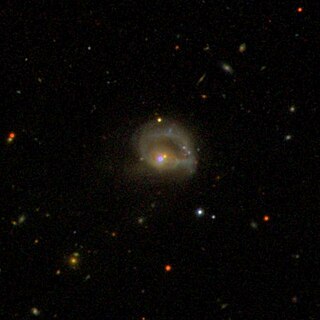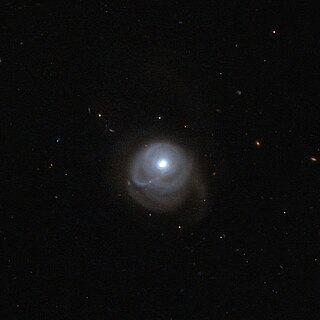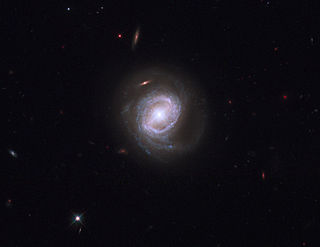
NGC 6240, also known as the Starfish Galaxy, is a nearby ultraluminous infrared galaxy (ULIRG) in the constellation Ophiuchus. It was discovered by French astronomer Édouard Stephan on 12 July 1871.
Luminous infrared galaxies or LIRGs are galaxies with luminosities, the measurement of brightness, above 1011 L☉. They are also referred to as submillimeter galaxies (SMGs) through their normal method of detection. LIRGs are more abundant than starburst galaxies, Seyfert galaxies and quasi-stellar objects at comparable luminosity. Infrared galaxies emit more energy in the infrared than at all other wavelengths combined. A LIRG's luminosity is 100 billion times that of the Sun.

APM 08279+5255 is a very distant, broad absorption line quasar located in the constellation Lynx. It is magnified and split into multiple images by the gravitational lensing effect of a foreground galaxy through which its light passes. It appears to be a giant elliptical galaxy with a supermassive black hole and associated accretion disk. It possesses large regions of hot dust and molecular gas, as well as regions with starburst activity.

Markarian 231 is a Type-1 Seyfert galaxy that was discovered in 1969 as part of a search of galaxies with strong ultraviolet radiation. It contains the nearest known quasar. Markarian 231 is located about 581 million light years away from Earth, in the constellation of Ursa Major.

NGC 7130 is a spiral galaxy located in the constellation Piscis Austrinus. It is located at a distance of about 220 million light years from Earth, which, given its apparent dimensions, means that NGC 7130 is about 100,000 light years across. It was discovered by John Herschel on September 25, 1834, and discovered independently by Lewis Swift on September 17, 1897. The location of the galaxy given in the New General Catalogue was off by 30 arcminutes in declination from the location of the galaxy.

NGC 985 is a ring galaxy in the constellation of Cetus. It is located about 550 million light years away from Earth, which means, given its apparent dimensions, that NGC 985 is approximately 160,000 light years across. It was discovered by Francis Leavenworth in 1886. It is a type 1 Seyfert galaxy.

Markarian 590, also known as NGC 863, NGC 866, and NGC 885, is an unbarred spiral galaxy located in the constellation Cetus. It is located at a distance of about 300 million light years from Earth, which, given its apparent dimensions, means that NGC 863 is about 110,000 light years across. It is a change looking Seyfert galaxy.

UGC 5101 is a galaxy merger located in the constellation Ursa Major. It is located at a distance of about 530 million light years from Earth. It is an ultraluminous infrared galaxy. The total infrared luminosity of the galaxy is estimated to be 1011.95 L☉ and the galaxy has a total star formation rate of 105 M☉ per year.

IRAS 05189-2524 is a galaxy merger located in the constellation Lepus. It is located 603 million light-years away from the Solar System and has an approximate diameter of 75,000 light-years.

Markarian 817 is a barred spiral galaxy located in the constellation Draco. It is located 456 million light-years from Earth, which, given its apparent dimensions, means that Markarian 817 is about 80,000 light-years across. It is a Seyfert galaxy.

IRAS F11119+3257 or simply as F11119+3257, is a galaxy located in constellation Ursa Major. With a redshift of 0.187580, it has a light travel time distance of 2.5 billion light-years and is considered an ultraluminous infrared galaxy (ULIRG).

PKS 1345+125 known as PKS 1345+12 and 4C +12.50, is an ultraluminous infrared galaxy (ULIG) with an active galactic nucleus, located in the constellation Boötes. With a redshift of 0.121740, the galaxy is located 1.7 billion light-years from Earth.

SDSS J135646.10+102609.0 known as SDSS J1356+1026 and J1356+1026, is a low redshift quasar and galaxy merger located in the constellation of Boötes. It is located 1.85 billion light years from Earth. It is an ultraluminous inflared galaxy. It is considered radio-quiet with an unresolved radio source.

Markarian 463 known as UGC 8850, is a galaxy merger located in the constellation Boötes. It is located 706 million light years from Earth. It is classified a double nucleus Seyfert galaxy.

IRAS 10565+2448 known as IRAS F10565+2448, is a galaxy merger located in the constellation of Leo. It is located at a distance of 625 million light years from Earth. It is classified as an ultraluminous infrared galaxy with an infrared luminosity of 1.2 x 1012 LΘ. It has a star formation rate of 131.8 MΘ yr−1.

Markarian 1014 known as PG 0157+001 is a quasar located in the constellation Cetus. It is located at a distance of 2.47 billion light years from Earth and is classified as a Seyfert galaxy as well as an ultraluminous infrared galaxy (ULIRG).

IRAS 07598+6508 known as IRAS F07599+6508, is a quasar located in the constellation of Camelopardalis. It is located 2.37 billion light years from Earth and is classified as both an ultraluminous infrared galaxy and a Seyfert galaxy.

Markarian 876 known as PG 1613+658, is an elliptical galaxy located in the constellation of Draco. With a velocity relative to the cosmic microwave background of 36,302 ± 60 kilometers per seconds, the galaxy is located 1.75 billion light years from Earth. It is a Seyfert galaxy.

IRAS 01003-2238 also known as IRAS F01004-2237 or simply F01004-2237, is a galaxy located in the constellation of Cetus. It is located 1.65 billion light years away from Earth and is a Seyfert galaxy and an ultraluminous infrared galaxy. IRAS 01003-2238 is also classified as a Wolf-Rayet galaxy, making the object one of the most distant known.

IC 5063 is a post-merger system and is a Seyfert 2 galaxy. This active galactic nucleus (AGN) produces on the one hand interactions with the interstellar medium (ISM) and large radio outflows. On the other hand, the accretion disk around the supermassive black hole, produces crepuscular rays. It is the first discovered case of a black hole disk producing such rays, but circumstellar disks around some young stars are already known to produce similar shadows. The crepuscular rays were first noted in an image by Judy Schmidt, who posted her image of IC 5063 on the social media platform Twitter.



















